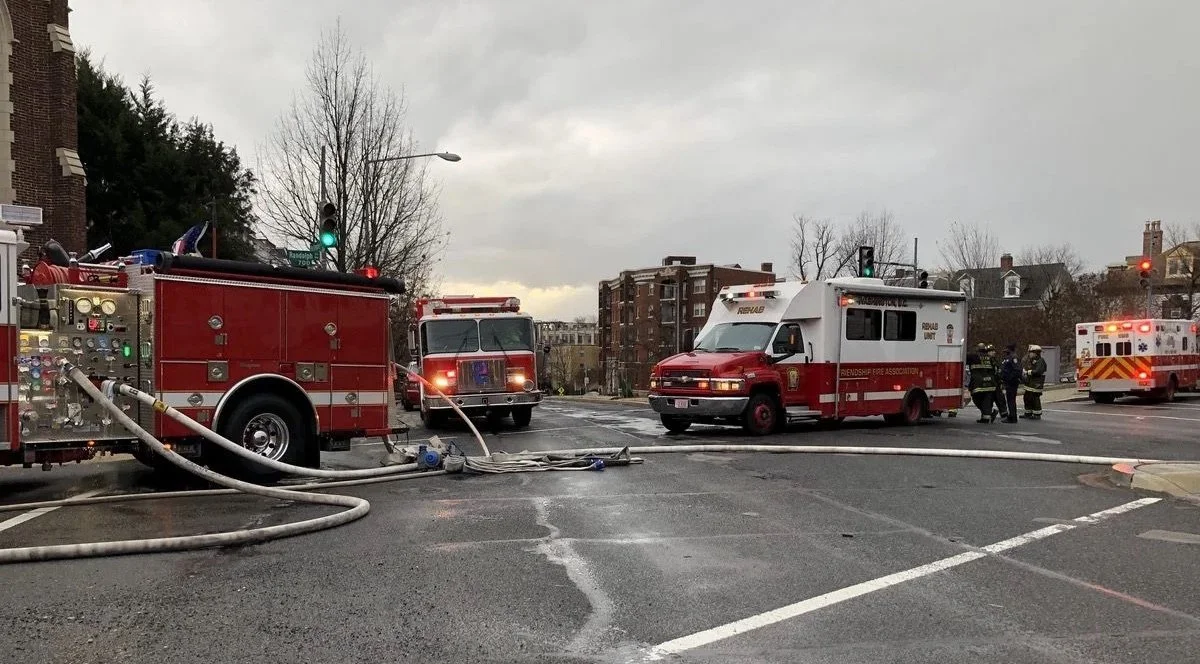Is DDOT using incomplete data for traffic safety analysis?
/One of the new all-way stop signs at Quincy & Kansas
While researching the article about the stop signs needed at Quincy Street and Kansas Avenue, I realized there might be a disconnect with how DDOT determines traffic safety measures for specific areas of the District. The issue at question, at a high level, is that DDOT uses police reports filed by MPD officers as one of their higher-weighted (more important) criteria for determining if an intersection or roadway has traffic safety issues; however, here’s the kicker: MPD officers do not file reports for collisions that only involve property damage. Theoretically, this means that if an intersection or roadway has a high number of vehicle collisions that only result in vehicle body damage and no injuries, then MPD wouldn’t file reports, and DDOT might not have an accurate safety analysis for that area.
For the recent four-way stop sign installed at Quincy Street and Kansas Avenue NW, DDOT’s crash data showed that a stop sign was not warranted. It was either political expediency (after all, Councilmember Brandon Todd was involved and motivated to help residents) or the fact that DDOT finally sent people to the intersection over the course of two days to physically study traffic, that determined there was in fact a need for the new four-way stop.
From my interviews with MPD and DDOT as well as my own research, it seems that DDOT may be making traffic safety decisions based on analysis of incomplete crash data. The only way to know for sure is to have DDOT take a closer look at their reporting and analysis methodology.
To help understand how collision reporting was handled and how traffic safety measures were determined, I reached out to leadership of both agencies. I was directed to the public affairs departments for both (not to their respective subject matter experts), so that’s where part of my research answers came from. The rest came from reading the reporting policies of MPD listed online, and the crash data analysis reports and documentation found on DDOT’s website. (All links are at the end of the article.)
It’s About the Reports — Let’s Start with MPD
There has been concern among residents that MPD is not filing reports on all collisions. However, according to MPD policy as stated in General Order 401.3 (updated January 14, 2015), residents are wrong. Section 5.A.3 of MPD’s General Order states that collisions involving minor property damage do not require a report to be filed. Here’s a quick look at the policy (bracketed text added by me for clarification):
Minor Damage
a. [Police officers] are not required to complete a PD Form 10 [“a traffic crash report”] for minor damage including, but not limited to, damage that renders a motor vehicle temporarily inoperable [like a broken windshield, flat tire, busted lights or body damage that can be realigned and the vehicle driven].
b. For crashes involving minor damage where no PD Form 10 is required, [officers] shall provide the involved parties with the “Government of the District of Columbia Motor Vehicle Crash Report for PROPERTY DAMAGE ONLY” [form].
What this means: If you are in a car accident and no one is injured, then the officers won’t be writing up a police report. If you ask for one, the officers are supposed to tell you no, then give you a Motor Vehicle Crash Report form that YOU fill out and send to DDOT to report the collision. (You can find that form on both MPD’s and DDOT’s websites.)
There ARE times an officer will file a report: If the crash involves an injury, if one of the vehicles needs to be towed, if the vehicle owner/operator is not at the scene of the crash, involves a government vehicle (DC or federal), a diplomat, a bus or taxi or if the accident involved a crime, etc. (The list is rather long.)
A real world example:
Residents who live around the Quincy and Kansas intersection claim to have seen or heard collisions occurring pretty often. According to Russ Breckenridge, a Kansas Ave resident, “There were many times I'd walk thru the intersection to find accident debris from some sort of collision. Sitting in our house, the sound of screeching brakes and honking horns was nearly constant. We would routinely see near-misses between vehicles or vehicles and pedestrians from our porch.”
So let’s say "Car A" pulls out from Quincy Street at the wrong time and hits "Car B" traveling south on Kansas Avenue (this happened last week). Passenger in Car B calls 911 and summons the police. The call type is logged by the Office of Unified Communications (OUC), the separate agency that handles 911 calls, in the computer-aided dispatch (CAD) system. MPD officers show up, determine no one is injured, no laws violated, no special exceptions, etc. so no need to write a report. Then, according to policy, the officers make sure the accident participants share information, determine the vehicles are still operational, give them a paper Motor Vehicle Crash Report form to submit to DDOT and then transmit a “10-8, no report” back to their dispatch and go back to fighting crime.
No report gets filed with DDOT, so except for a 911 call logged to CAD, there is no data or information on this collision. Was there minor damage or extensive damage? Are vehicles getting sideswiped often? Is the road slippery in the rain? DDOT has no way of knowing that data unless the participants take it upon themselves to submit the Motor Vehicle Crash Report. And like me, I doubt many have heard of it before now.
So why doesn’t MPD take reports in all cases then? “We used to file reports for all traffic accidents,” said Lieutenant Sean Conboy from the MPD public information office. “The policy changed in the late 80s when the amount of traffic going through the District, and the number of accidents, largely increased.”
In other words, when traffic in DC got more crowded and the numbers of accidents also jumped up, the amount of time spent giving out speeding tickets, responding to collisions and filing reports became problematic. It’s one reason DC has switched to using automated methods for reducing speed and other moving violations like running red lights. A camera can track the car, allowing a cop to focus on investigating crimes (and it’s safer for the police). Not filing reports for crashes involving property damage only, according to Lt. Conboy, “Allows us to respond more quickly to serious accidents and violent crime.”
It’s not worth MPD’s time to fill out reports on minor accidents where no fault is obvious (my words). An insurance company is going to investigate a collision and assign blame, whether or not there’s a written police report. So from MPD’s perspective, there’s no benefit to taking the report for property damage crashes.
“Traffic safety is a high priority for us,” said Lt Conboy. “MPD analyzes calls for services, including accidents, regardless of type, and look at CAD data on a regular basis.”
Analyzing the Data — Let’s Look at DDOT
DDOT works pretty hard to understand traffic patterns and mitigate the risk of collisions, injury and fatalities around the District. To do so, DDOT utilizes the Traffic Accident Analysis and Research System (TARAS) database to obtain crash data statistics and reports. “TARAS automatically accesses MPD’s crash database and downloads crash data on a daily basis,” said Keith St. Clair, DDOT’s communications director. “The TARAS database generates various crash data statistics and reports based on the different query parameters. Sometimes, DDOT staff also contacts MPD staff to obtain crash information for the specific accident.”
However, according to the most recent traffic study ("2014 Traffic Safety Statistics Report for the District of Columbia (2010-2012"), completed by Howard University for DDOT in March 2014, crash analysis is done using TARAS and police reports. In fact, the study authors specifically point out that they use police reports (knows as PD-10 crash reports) as the source for crash data presented in their study, citing “The data fields in TARAS include crash location, date, time, crash type, crash severity, and environmental conditions.” (2014 Report, Section 1.1, page 10.)
Data is pulled from MPD servers and aggregated together to determine collision frequency, damage type and overall risk:
“Descriptive statistics were used to present the basic characteristics of traffic crashes and to identify factors that may have influenced their occurrence. The factors considered include vehicle characteristics, characteristics of involved persons (e.g., drivers, passengers, and pedestrians), physical environment (e.g., roadway type, traffic conditions, and weather conditions), and temporal crash characteristics (e.g., year, month, day, and time of day). The frequencies of crashes are summarized for each factor using descriptive statistics.” (2014 Report, Section 2.1, page 12.)
But if MPD only files reports for certain crashes and not others, then how complete is this Howard University study used by DDOT? Where is this TARAS data coming from then? It raises the question on thoroughness and accuracy of DDOT’s data analysis.
When I asked Mr. St Clair if police reports were critical to DDOT’s analysis for the Quincy and Kansas intersection, he replied, “Yes, crash data from MPD is one of the primary criterion when DDOT makes decisions regarding an all-way stop, in addition to scene assessments.”
“The criteria for all-way stops are fundamentally based upon the traffic volumes and classifications of the two roadways in question,” said Mr. St Clair. “In this instance, with Kansas Avenue being an arterial (with higher volume) and Quincy Street being local (lower volume), providing stop signs on Kansas is not warranted under those two criteria.”
He then went on to explain that, “The crash history data provides an additional measure for evaluation and looks at whether a certain number of crashes over the span of a 12-month period have occurred (5 in this case) that can be corrected by installing all-way stop signs (preventing, for example, angle crashes). Previous analyses showed 3 reported crashes for Quincy and Kansas over the past year.”
“DDOT sent a team to observe traffic patterns at the intersection of Quincy Street and Kansas Avenue NW,” continued Mr. St Clair. “The following day, they deployed a Traffic Control Officer to the intersection during the morning and evening commutes to monitor the safety of pedestrians there. Based on the visual assessment of the intersection and the data received from MPD about two crashes this past weekend, DDOT is prepared to move forward with the installation of stop signs on Kansas Avenue at the intersection with Quincy Street.”
DDOT replaced the "stop for pedestrians in crosswalks" sign with a new all-way stop sign at Quincy & Kansas.
That’s great, a four-way stop is installed and residents are happy. But it only happened because DDOT had a physical presence at the intersection for two days. Their prior data analysis showed this to be a safe intersection. The crash data gathered by DDOT from TARAS and appropriately filed police reports did not show a high enough crash severity or frequency to put a four-way stop sign into the intersection.
“We aren't looking to place blame,” said Russ Breckenridge, “but I do hope our community engagement leads to changes in how collisions are tracked in DC. I can only imagine that other neighborhoods have similar intersections that need attention. I'm sure they share our frustration. While I understand that filling out accident reports takes time and pulls officers off the street, I’d like to see MPD, in coordination with DDOT, develop an abbreviated accident reporting form that is less time-consuming so that we can have accurate crash data to make the city's streets safer for pedestrians, bikers and cars.”
The question for DDOT and DC government to answer is if DDOT has a data collection and analysis problem, and if that is causing safety issues to remain in DC for longer than they should.
Maybe I’m wrong — but I’d sure like to see DDOT investigate.
See also... DC's Vision Zero Program
DC has an ongoing campaign called Vision Zero, who's mission is: "By the year 2024, Washington, DC will reach zero fatalities and serious injuries to travelers of our transportation system, through more effective use of data, education, enforcement, and engineering."
On the Vision Zero site, you'll find the following:
Vision Zero Safety Map: Use this map to identify any and all locations at which you have noticed hazardous conditions or behavior.
Tweets: Tweet your suggestions using #VZDC
Engineering and Infrastructure: Careful data analysis will identify specific locations that require new interventions and safety strategies. .
Enforcement and Education: Greater enforcement and education will protect our most vulnerable travelers. Infrastructure alone will not reduce fatalities and serious injuries to zero.
Data: Vision Zero strategies will be informed by a systematic data and information-driven process that identifies and prioritizes interventions with the greatest potential to eliminate fatalities and serious injuries.
Maybe Vision Zero is a start in the right direction, but only if they get data analysis right.
Related Links:




















